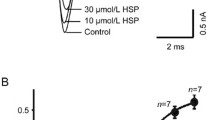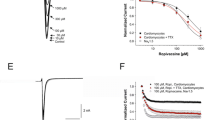Abstract
Small G-proteins of Rho family modulate the activity of several classes of ion channels, including K+ channels Kv1.2, Kir2.1, and ERG; Ca2+ channels; and epithelial Na+ channels. The present study was aimed to check the RhoA potential regulatory effects on Na+ current (INa) transferred by Na+ channel cardiac isoform NaV1.5 in heterologous expression system and in native rat cardiomyocytes. Whole-cell patch-clamp experiments showed that coexpression of NaV1.5 with the wild-type RhoA in CHO-K1 cell line caused 2.7-fold decrease of INa density with minimal influence on steady-state activation and inactivation. This effect was reproduced by the coexpression with a constitutively active RhoA, but not with a dominant negative RhoA. In isolated ventricular rat cardiomyocytes, a 5-h incubation with the RhoA activator narciclasine (5 × 10−6 M) reduced the maximal INa density by 38.8%. The RhoA-selective inhibitor rhosin (10−5 M) increased the maximal INa density by 25.3%. Experiments with sharp microelectrode recordings in isolated right ventricular wall preparations showed that 5 × 10−6 M narciclasine induced a significant reduction of action potential upstroke velocity after 2 h of incubation. Thus, RhoA might be considered as a potential negative regulator of sodium channels cardiac isoform NaV1.5.




Similar content being viewed by others
References
Adam O, Lavall D, Theobald K, Hohl M, Grube M, Ameling S, Sussman MA, Rosenkranz S, Kroemer HK, Schäfers HJ, Böhm M, Laufs U (2010) Rac1-induced connective tissue growth factor regulates connexin 43 and N-cadherin expression in atrial fibrillation. J Am Coll Cardiol 55(5):469–480. https://doi.org/10.1016/j.jacc.2009.08.064
Akbar H, Duan X, Saleem S, Davis AK, Zheng Y (2016) RhoA and Rac1 GTPases differentially regulate agonist-receptor mediated reactive oxygen species generation in platelets. PLoS One 11(9):e0163227. https://doi.org/10.1371/journal.pone.0163227
Andrieu G, Quaranta M, Leprince C, Cuvillier O, Hatzoglou A (2014) Gem GTPase acts upstream Gmip/RhoA to regulate cortical actin remodeling and spindle positioning during early mitosis. Carcinogenesis. 35(11):2503–2511. https://doi.org/10.1093/carcin/bgu185
Anumonwo JMB, Lopatin AN (2010) Cardiac strong inward rectifier potassium channels. J Mol Cell Cardiol 48(1):45–54. https://doi.org/10.1016/j.yjmcc.2009.08.013
Aoki H, Izumo S, Sadoshima J (1998) Angiotensin II activates RhoA in cardiac myocytes: a critical role of RhoA in angiotensin II-induced premyofibril formation. Circ Res 82(6):666–676. https://doi.org/10.1161/01.res.82.6.666
Boyer SB, Slesinger PA, Jones SVP (2009) Regulation of Kir2.1 channels by the Rho-GTPase, Rac1. J Cell Physiol 218(2):385–393. https://doi.org/10.1002/jcp.21610
Cachero TG, Morielli AD, Peralta EG (1998) The small GTP-binding protein RhoA regulates a delayed rectifier potassium channel. Cell 93(6):1077–1085. https://doi.org/10.1016/S0092-8674(00)81212-X
Casini S, Tan HL, Demirayak I, Remme CA, Amin AS, Scicluna BP, Chatyan H, Ruijter JM, Bezzina CR, van Ginneken AC, Veldkamp MW (2010) Tubulin polymerization modifies cardiac sodium channel expression and gating. Cardiovasc Res 85(4):691–700. https://doi.org/10.1093/cvr/cvp352
De Boer TP, Houtman MJC, Compier M, Van Der Heyden MAG (2010) The mammalian K(IR)2.x inward rectifier ion channel family: expression pattern and pathophysiology. Acta Physiol 199:243–256. https://doi.org/10.1111/j.1748-1716.2010.02108.x
Dulong C, Fang YJ, Gest C, Zhou MH, Patte-Mensah C, Mensah-Nyagan AG, Vannier JP, Lu H, Soria C, Cazin L, Mei YA, Varin R, Li H (2014) The small GTPase RhoA regulates the expression and function of the sodium channel Nav1.5 in breast cancer cells. Int J Oncol 44(2):539–547. https://doi.org/10.3892/ijo.2013.2214
Hallaq H, Yang Z, Viswanathan PC, Fukuda K, Shen W, Wang DW, Wells KS, Zhou J, Yi J, Murray KT (2006) Quantitation of protein kinase A-mediated trafficking of cardiac sodium channels in living cells. Cardiovasc Res 72(2):250–261. https://doi.org/10.1016/j.cardiores.2006.08.007
Haverinen J, Vornanen M (2004) Temperature acclimation modifies Na+ current in fish cardiac myocytes. J Exp Biol 207:2823–2833. https://doi.org/10.1242/jeb.01103
Jones SVP (2003) Role of the small GTPase Rho in modulation of the inwardly rectifying potassium channel Kir2.1. Mol Pharmacol 64(4):987–993. https://doi.org/10.1124/mol.64.4.987
Lefranc F, Sauvage S, Goietsenoven GV, Megalizzi V, Lamoral-Theyes D, Debeir O, Spiegl-Kreinecker S, Berger W, Mathieu V, Decaestecker C, Kiss R (2009) Narciclasine, a plant growth modulator, activates Rho and stress fibers in glioblastoma cells. Mol Cancer Ther 8(7):1739–1750. https://doi.org/10.1158/1535-7163.MCT-08-0932
Marsman RF, Bezzina CR, Freiberg F, Verkerk AO, Adriaens ME, Podliesna S, Chen C, Purfürst B, Spallek B, Koopmann TT, Baczko I, Dos Remedios CG, George AL Jr, Bishopric NH, Lodder EM, de Bakker JM, Fischer R, Coronel R, Wilde AA, Gotthardt M, Remme CA (2014) Coxsackie and adenovirus receptor is a modifier of cardiac conduction and arrhythmia vulnerability in the setting of myocardial ischemia. J Am Coll Cardiol 63(6):549–559. https://doi.org/10.1016/j.jacc.2013.10.062
Matamoros M, Pérez-Hernández M, Guerrero-Serna G, Amoros I, Barana A, Nunez M, Ponce-Balbuena D, Sacristán S, Gómez R, Tamargo J, Caballero R, Jalife J (2016) Nav1.5 N-terminal domain binding to α1-syntrophin increases membrane density of human Kir2.1, Kir2.2 and Nav1.5 channels. Cardiovasc Res 110:279–290. https://doi.org/10.1093/cvr/cvw009
Milstein ML, Musa H, Balbuena DP, Anumonwo JMB, Auerbach DS, Furspan PB, Hou L, Hu B, Schumacher SM, Vaidyanathan R (2012) Dynamic reciprocity of sodium and potassium channel expression in a macromolecular complex controls cardiac excitability and arrhythmia. Proc Natl Acad Sci 109:E2134–E2143. https://doi.org/10.1073/pnas.1109370109
Motlagh D, Alden KJ, Russell B, García J (2002) Sodium current modulation by a tubulin/GTP coupled process in rat neonatal cardiac myocytes. J Physiol 540(1):93–103. https://doi.org/10.1113/jphysiol.2001.013474
Murray KT, Hu N, Daw JR, Shin HG, Watson MT, Mashburn AB, George AL Jr (1997) Functional effects of protein kinase C activation on the human cardiac Na+ channel. Circ Res 80(3):370–376. https://doi.org/10.1161/01.RES.80.3.370
Pérez-Hernández M, Matamoros M, Alfayate S, Nieto-Marín P, Utrilla R, Tinaquero D, de Andrés R, Crespo T, Ponce-Balbuena D, Willis BC, Jiménez-Vazquez EN, Guerrero-Serna G, da Rocha AM, Campbell K, Herron TJ, Díez-Guerra FJ, Tamargo J, Jalife J, Caballero R, Delpón E (2018) Brugada syndrome trafficking–defective Nav1.5 channels can trap cardiac Kir2.1/2.2 channels. JCI. Insight 3(18):e96291. https://doi.org/10.1172/jci.insight.96291
Pochynyuk O, Medina J, Gamper N, Genth H, Stockand JD, Staruschenko A (2006) Rapid translocation and insertion of the epithelial Na+ channel in response to RhoA signaling. J Biol Chem 281(36):26520–26527. https://doi.org/10.1074/jbc.M603716200
Ponce-Balbuena D, Guerrero-Serna G, Valdivia CR, Caballero R, Diez-Guerra FJ, Jiménez-Vázquez EN, Ramírez RJ, Monteiro da Rocha A, Herron TJ, Campbell KF, Willis BC, Alvarado FJ, Zarzoso M, Kaur K, Pérez-Hernández M, Matamoros M, Valdivia HH, Delpón E, Jalife J (2018) Cardiac Kir2.1 and NaV1.5 channels traffic together to the sarcolemma to control excitability. Circ Res 122:1501–1516. https://doi.org/10.1161/CIRCRESAHA.117.311872
Rossignol TM, Jones SVP (2006) Regulation of a family of inwardly rectifying potassium channels (Kir2) by the m1 muscarinic receptor and the small GTPase Rho. Pflugers Arch - Eur J Physiol 452(2):164–174. https://doi.org/10.1007/s00424-005-0014-9
Sah VP, Minamisawa S, Tam SP, Wu TH, Dorn GW 2nd, Ross J Jr, Chien KR, Brown JH (1999) Cardiac-specific overexpression of RhoA results in sinus and atrioventricular nodal dysfunction and contractile failure. J Clin Invest 103(12):1627–1634. https://doi.org/10.1172/JCI6842
Savio-Galimberti E, Argenziano M, Antzelevitch C (2017) Cardiac arrhythmias related to sodium channel dysfunction. В: Handbook of Experimental Pharmacology. pp 331–354
Shang LL, Pfahnl AE, Sanyal S, Jiao Z, Allen J, Banach K, Fahrenbach J, Weiss D, Taylor WR, Zafari AM, Dudley SC Jr (2007) Human heart failure is associated with abnormal C-terminal splicing variants in the cardiac sodium channel. Circ Res 101(11):1146–1154. https://doi.org/10.1161/CIRCRESAHA.107.152918
Storey NM, O’Bryan JP, Armstrong DL (2002) Rac and Rho mediate opposing hormonal regulation of the ether-A-go-go-related potassium channel. Curr Biol 12(1):27–33. https://doi.org/10.1016/S0960-9822(01)00625-X
Strassheim D, Gerasimovskaya E, Irwin D, Dempsey EC, Stenmark K, Karoor V (2019) RhoGTPase in vascular disease. Cells 8(6):E551. https://doi.org/10.3390/cells8060551
Sussman MA, Welch S, Walker A, Klevitsky R, Hewett TE, Price RL, Schaefer E, Yager K (2000) Altered focal adhesion regulation correlates with cardiomyopathy in mice expressing constitutively active rac1. J Clin Invest 105(7):875–886. https://doi.org/10.1172/JCI8497
Takai Y, Sasaki T, Matozaki T (2001) Small GTP-binding proteins. Physiol Rev 81(1):153–208. https://doi.org/10.1152/physrev.2001.81.1.153
Utrilla RG, Nieto-Marín P, Alfayate S, Tinaquero D, Matamoros M, Pérez-Hernández M, Sacristán S, Ondo L, de Andrés R, Díez-Guerra FJ, Tamargo J, Delpón E, Caballero R (2017) Kir2.1-Nav1.5 channel complexes are differently regulated than Kir2.1 and Nav1.5 channels alone. Front Physiol 8:903. https://doi.org/10.3389/fphys.2017.00903
van Bemmelen MX, Rougier JS, Gavillet B et al (2004) Cardiac voltage-gated sodium channel Nav1.5 is regulated by Nedd4-2 mediated ubiquitination. Circ Res 95(3):284–291. https://doi.org/10.1161/01.RES.0000136816.05109.89
Veettil MV, Sharma-Walia N, Sadagopan S, Raghu H, Sivakumar R, Naranatt PP, Chandran B (2006) RhoA-GTPase facilitates entry of Kaposi's sarcoma-associated herpesvirus into adherent target cells in a Src-dependent manner. J Virol 80(23):11432–11446. https://doi.org/10.1128/JVI.01342-06
Wei L, Imanaka-Yoshida K, Wang L, Zhan S, Schneider MD, DeMayo FJ, Schwartz RJ (2002) Inhibition of Rho family GTPases by Rho GDP dissociation inhibitor disrupts cardiac morphogenesis and inhibits cardiomyocyte proliferation. Development 129(7):1705–1714
Wennerberg K (2005) The Ras superfamily at a glance. J Cell Sci 118(5):843–846. https://doi.org/10.1242/jcs.01660
Yatani A, Irie K, Otani T, Abdellatif M, Wei L (2005) RhoA GTPase regulates L-type Ca 2+ currents in cardiac myocytes. Am J Physiol Circ Physiol 288(2):H650–H659. https://doi.org/10.1152/ajpheart.00268.2004
Yoon J-Y, Ho W-K, Kim S-T, Cho H (2009) Constitutive CaMKII activity regulates Na+ channel in rat ventricular myocytes. J Mol Cell Cardiol 47(4):475–484. https://doi.org/10.1016/j.yjmcc.2009.06.020
Young KA, Caldwell JH (2005) Modulation of skeletal and cardiac voltage-gated sodium channels by calmodulin. J Physiol 565(2):349–370. https://doi.org/10.1113/jphysiol.2004.081422
Zimmer T, Haufe V, Blechschmidt S (2014) Voltage-gated sodium channels in the mammalian heart. Glob Cardiol Sci Pract 2014(4):449–463. https://doi.org/10.5339/gcsp.2014.58
Funding
The study was supported by the Russian Foundation for Basic Research [18-315-20049 to D.V.A.].
Author information
Authors and Affiliations
Corresponding author
Ethics declarations
Conflicts of interest
The authors declare that they have no conflicts of interest.
Research involving human participants and/or animals
The investigation complies with the ARRIVE guidelines and conforms to the guidelines from Directive 2010/63/EU of the European Parliament on the protection of animals used for scientific purposes and was approved by the Bioethical Committee of Moscow State University.
Informed consent
Not applicable.
Additional information
Publisher’s note
Springer Nature remains neutral with regard to jurisdictional claims in published maps and institutional affiliations.
Key points
• Coexpression with the RhoA inhibits Na+ current (INa) in heterologous expression system
• The RhoA activator decreases INa, while its inhibitor increases INa in rat cardiomyocytes
• In rat ventricular myocardium, the RhoA activator slows down action potential upstroke
• Thus, the RhoA might be considered as a new potential regulator of cardiac Na+ channels
Rights and permissions
About this article
Cite this article
Abramochkin, D.V., Filatova, T.S., Pustovit, K.B. et al. Small G—protein RhoA is a potential inhibitor of cardiac fast sodium current. J Physiol Biochem 77, 13–23 (2021). https://doi.org/10.1007/s13105-020-00774-w
Received:
Accepted:
Published:
Issue Date:
DOI: https://doi.org/10.1007/s13105-020-00774-w




